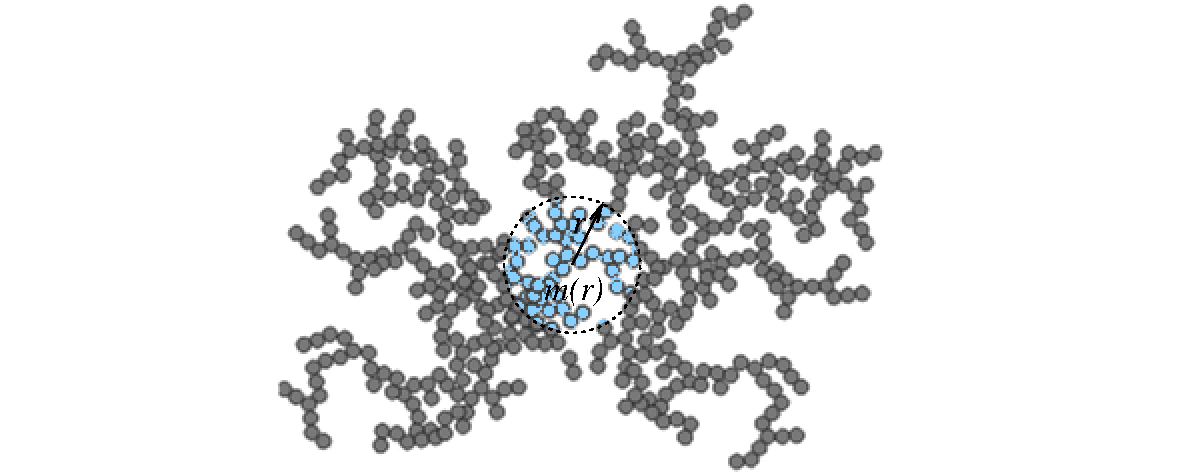In describing the configuration of a colloidal system, one often deals with either, disordered fluid states, disordered jammed states or crystalline states (so an underlying lattice structure), but in contrast, what is a fractal structure for such a system? How does it deviate from the two extrema of fully disordered and fully ordered crystalline states?
1 Answer
When diffusion is the primary transport mechanism, fractal patterns may arise as the result of diffusion-limited aggregation or more specifically diffusion limited cluster aggregation (DLCA): where the colloidal particles display Brownian motion until they meet and attract, generating clusters of dimension typically between $1.7$ and $1.8$ (though that's also geometry dependent).
When a potential barrier must be overcome in order for the aggregate to form (i.e., the force between the particles is not only attractive), the process is called reaction limited cluster aggregation (RLCA) and leads to more compact clusters, with higher dimensions (e.g., $2.3$).
These clusters being fractal means here, essentially, that they are self similar ("look the same") when regarded at different scales (say, $\mu$m, mm, cm, etc.). In the case of colloidal aggregation, that self similarity can come about in the following way: in a first moment, colloidal particles form small clumps, then, these small aggregates form bigger ones, and then these form even bigger ones, and so on.
As for the meaning of the (typically) fractional value for the dimension of fractals, there's a quite intuitive way to understand it:
First, consider the object, fractal or not, immersed in a higher-dimensional usual space; Concretely, let's use the 2-D Euclidean space;
Then, consider a tiny volume "in the middle" of the object, for example, a circle of radius $r$, and let it grow;
The mass $m$ of the object enclosed by the circle will increase as $r$ grows: if $m$ increases as a power of $r$: $$ m(r)\propto r^d, $$ then you can call $d$ the dimension of the object.
Some examples:
- For a long straight thread or needle, illustrated bellow, $m$ will grow approximately linearly with $r$, doubling when $r$ doubles, tripling when $r$ triples, and so on: that means $m\propto r^1$, i.e., $d=1$, and we say the object is approximately one dimensional.
A sheet of paper of superficial density $\mu$ will present $m=\mu A$, where $A$ is the area of the circle, i.e.: $m=\pi\mu r^2$, i.e., $d=2$ and that's a two dimensional object.
Now what happens if we consider that self-similar aggregate? If we measure how much of its mass is enclosed by the circle, we'll find out that $$ m(r) \propto r^{1.7},$$ and we then say that its dimension is $d=1.7$.
-
$\begingroup$ Many thanks for your reply. If I may ask two questions having read your answer: i) but how do we formally (as in, is there some specific scaling behaviour that suggests it?) recognize these fractal structures? Informally, just looking at the pictures with naked eyes I wouldn't be able to tell if that s a fractal structure. ii) what do these dimensions that you mentioned mean? $\endgroup$ Commented Aug 23, 2017 at 13:13
-
$\begingroup$ @user929304, I updated my answer to include the information you asked. $\endgroup$– stafusaCommented Aug 23, 2017 at 16:11
-
$\begingroup$ Actually, it was my understanding that DLA is multifractal $\endgroup$– TLDRCommented Aug 23, 2017 at 16:14
-
1$\begingroup$ @fs137, Interesting remark, actually it's unclear ([see this paper][1]) whether DLA is multifractal, but even if it is, a "monofractal" analysis is incomplete, but not incorrect. For the apparent level of the OP, considering only mass or box-counting dimensions should be enough. [1]: sciencedirect.com/science/article/pii/S037843711300277X $\endgroup$– stafusaCommented Aug 23, 2017 at 16:28
-
$\begingroup$ Thank you very much for the edit. Well then doesn't this self-similarity mean that we have power laws (thus scale free description) describing the behaviour of the system? $\endgroup$ Commented Aug 29, 2017 at 14:48



